Brown Water in The Toilet? – 7 Ways To Fix It!
Last Updated on October 5, 2023 by toilethaven
In most houses, the water supplied to toilets is from the same source as the one supplied to showers, sinks, dishwashers, and washing machines.
If there is a problem with the water supply to the toilet, you would expect to find the same in other fixtures. That, however, is not always the case.
That is why you will find that the water in your toilet is brown or sometimes yellowish, but water in other fixtures is clear. But why is the water in your toilet brown?
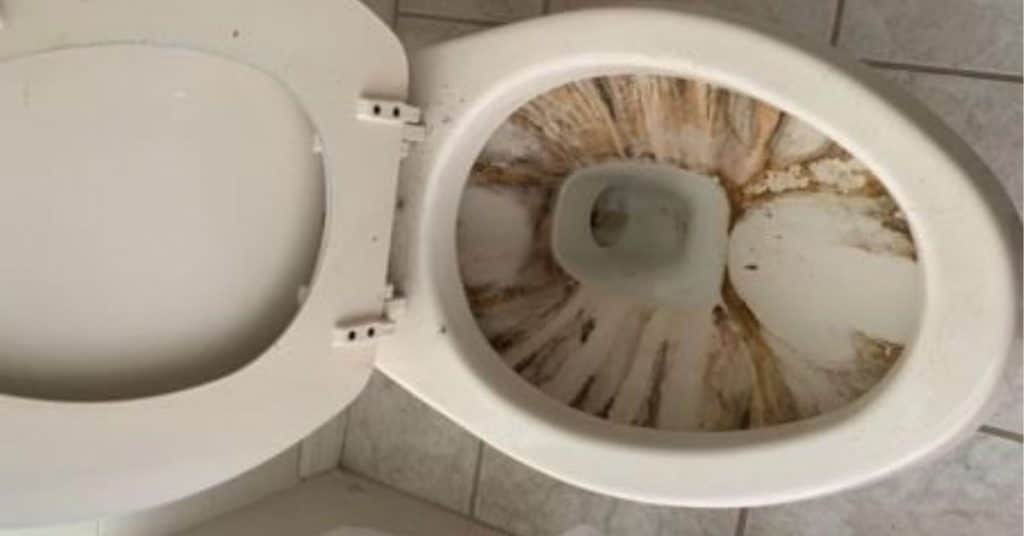
Corroded galvanized pipes, excess sediment in the toilet tank, or repairs of water systems by the city water department often cause brown water in a toilet. A damaged well or a leaking pipe could also cause it.
The brown color in your toilet is dissolved rust. The water pressure causes the rust to flake off from corroded pipes and settle at the bottom of the toilet tank. The rust dissolves in water to form brown water, which appears when you flush the toilet.
To get rid of brown water in a toilet, flush the toilet a couple of times and clean the tank. You can hire a plumber to hydrojet your water pipes, inspect the well, or even replace old galvanized pipes with PVC or copper pipes. Installing a water softener will also prevent the problem from recurring.
Brown water in the toilet and the sink points to corroded galvanized steel pipes. It could also be that the local water department is flushing out pipes or testing hydrants. It could be damaged if you are on a well, causing organic matter or debris to dissolve in the water.
If you notice brown water in your toilet after vacation, minerals in the water have settled at the bottom of the tank to form sediment. Also, the water in the pipes has dissolved the rust from the corroded pipes and turned brown.
Toilet water turning brown after a few hours indicates a high concentration of hard water minerals, especially iron. Rust/corrosion flaking off old galvanized pipes will also cause the water to turn brown.
Related: Check out how to get rid of rust stains from a toilet bowl in this post.
Troubleshooting Brown Water in a Toilet
The first thing you should do when you notice brown water in your toilet is to check if the problem is affecting only the toilet or if the whole house is affected.
Turn on the sink faucet, shower, or tub faucet, and check if the water is brown or clear. Since the toilet is only connected to the main cold water supply, do not turn on the sink or shower hot water faucet. Just check the cold water faucet.
The problem is localized to your toilet if the water flowing from all the other fixtures is clear. That is a good sign since fixing the problem will be easy and cheap.
If the water from all the other fixtures is brown as well, you definitely have a problem with the whole house.
At that time, you should talk to your neighbors and see if they are having the same problem as well. That way, you will know if the problem is only restricted to your house or the entire neighborhood.
If, after inquiries, you find out that your neighbors have the same problem, call your local water department. Chances are high that they are/were repairing water systems and/or testing hydrants, which caused the sediment to dissolve in the water being supplied to the neighborhood.
On the other hand, if the brown water is only in your house, you most likely have a problem with your water pipes. Either they are too old and corroded, or there is a leak somewhere.
How to Fix Brown Toilet Water
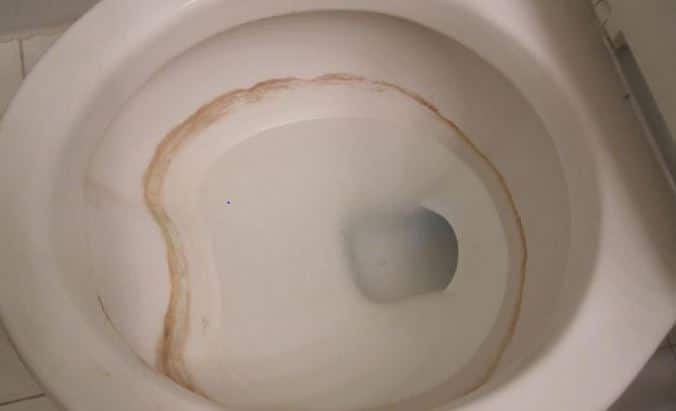
Getting rid of brown water from a toilet can be easier. This is especially true if the problem only affects the toilet and not other fixtures.
The following are some of the ways to get rid of brown water in a toilet:
1. Clean the Toilet Tank
Unlike in other fixtures where the water comes directly from the pipe, in a toilet, the water is temporarily stored in the toilet tank.
That time when the water stays in the tank allows the dissolved minerals to settle at the bottom of the tank, forming a layer of sediment.
When the toilet is flushed, the sediment is stirred, resulting in the sediment dissolving in the water and, hence, the brown water inside the toilet.
The solution to this problem is to clean the tank. That way, you will remove the sediment and ensure the water inside the tank is clear.
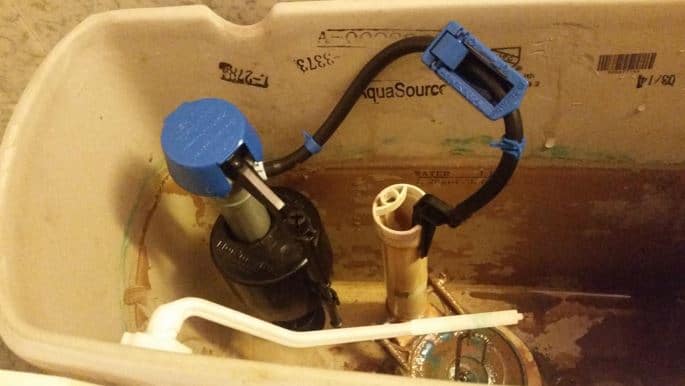
Here is how to clean the tank:
- Flush the toilet a couple of times. This will help you remove as much of the sediment as possible.
- Turn off the toilet water supply. The shut-off valve is on the wall behind the toilet.
- Use a sponge to soak the water still left in the tank.
- Fill the tank with vinegar. The vinegar will soak up all the minerals, even those attacking the wall of the tank. Let the vinegar sit for 6 hours or even longer.
- Flush down the vinegar.
- Spray your usual dish soap all over the interior of the tank, then use a brush with a long handle to scrub every corner of the tank.
- Turn on the water supply to the toilet with the tank lid still removed. Check if the incoming water is clear or brown. If it is clear, then your problem has been solved. On the other hand, if it is still brown, the problem is with the pipes or water source.
2. Call the Water Department
Due to the accumulation of debris in pipes and water tanks, water utility companies will occasionally flush out the sediment, which, as you guessed, will end up in houses.
Testing and flushing water hydrants can also blow sediment from the city water pipes to people’s homes.
If there is a leak or other repairs in the main water supply lines, the dirt in the pipes will wash up towards homes and hence the brown color in water.
You can pick up the phone, contact your local water department, and ask if one of the things described above is happening.
If that is the case, they will advise you to open all your faucets and let the water run for about 10 minutes or until the water clears.
3. Check if there are Leaks
Your house is connected to the city water supply line near the street. The service line is the main water pipe from the street to your house.
If the service line is made of galvanized steel pipes, as is the case in many homes, it will, at some point, start to leak.
You might not know that there is always a layer of sediment at the bottom of the water pipe. The sediment is usually made of pipe corrosion, dirt, and mineral deposits.
When the pipe starts to leak, the layer of sediment is disturbed; as a result, the debris dissolves in water and enters the house. That could be why you have brown water in your toilet.
A leaking pipe can also allow dirty water into the water supply pipes, especially after a storm.
To check if you have a leaking pipe, locate your water meter. The water meter with a steel or concrete lid will be near the curb or sidewalk.
Also, make sure that there is no running fixture in your house. For this test to be effective, there should not be any drop of water being used in the house.
After removing the lid, look for the meter’s leak detector. It looks like a gear or a small triangle. If this device is spinning, you have a leak somewhere. You do not leak if the leak detector is stationary.
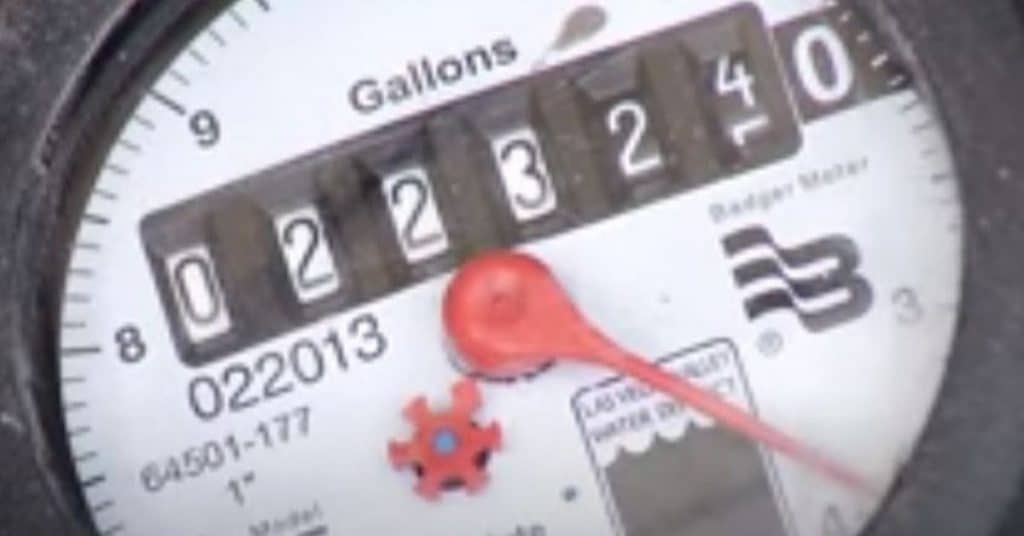
If you have a leaking pipe, I recommend hiring a plumber to find the leak and fix it.
4. Replace Water Pipes
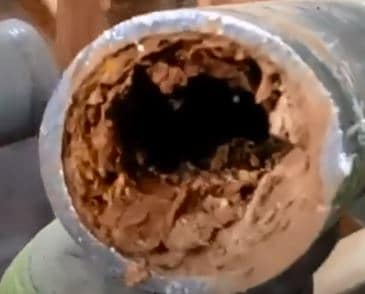
Corroded pipes are the main reason for brown water in toilets, sinks, and other fixtures. Old galvanized steel pipes were coated with zinc to prevent corrosion.
However, the zinc layer peeled off after some time, exposing the iron to oxygen, where it reacted to form iron oxide, also known as rust.
Accumulating rust inside water pipes also results in low water pressure due to the restriction created. After some time, water pressure causes the rust to flake off and is forced out into toilets and other fixtures in the form of brown water.
The rust can also clog shower heads, toilet fill valves, dishwashers, washing machine valves, and not faucet aerators, resulting in premature failure of appliances or low water pressure.
If you have galvanized steel pipes in your house and suffer brown water in toilets and other fixtures, replacing the pipes seems like the best option.
If the problem is specifically with the toilet, it could be that the water supply pipe to the toilet is the problematic one. You may opt to replace just that pipe and leave the others.
Remember that a rusted pipe will soon enough start to leak since its structural integrity has already been compromised.
The two common alternatives to galvanized pipe are copper and PVC. Both of them have their advantages and disadvantages.
5. Try Hydro Jetting Your Water Pipes
Hydrojetting is another solution for brown water in toilets and other fixtures. You don’t need to replace pipes all the time.
You could have brown water even when you have plastic or copper pipes. This is especially true if you have hard water in your house.
The iron deposits will settle in the pipes, resulting in brownish water discoloration. Rust from the city water pipes will also form a layer of sediment in the pipes.
In hydrojetting, water under very high pressure is used to clean the pipes and remove all the clogs and debris.
The plumber will first check your pipes and advise if the pipes are a good candidate for hydrojetting or if they will collapse under pressure.
If they are sure that the pipes can withstand the pressure, they go on and do the hydrojetting. Replacement of the pipes will be recommended if they are too weak to withstand the pressure.
6. Have Your Well Inspected
If you use water from a well, you could most likely be dealing with a damaged well. Construction activities, landscaping, storms, or earthquakes often cause that.
This causes organic matter and dirt to be dissolved in the water supplied to your house, hence the brown discoloration in your toilet water and other faucets.
Unfortunately, a well is not something you, a handyman, or just any other plumber can fix. You will need the services of a professional in that field to first inspect and then offer a solution for the problem.
7. Install a Water Softener
If you do not already have one, I recommend installing a water softener, especially if you live in an area with hard water.
Water softeners employ a system known as ion exchange, where hard water minerals like iron, calcium, and manganese are removed before they enter your house.
Installing a water softener will ensure that your water pipes will not corrode and that your fixtures like toilets, tubs, and sinks will not stain.
The hard water stains found in toilets and other fixtures are especially caused by iron and manganese.
You can install a water softener using water from a well or the city. These units are also easy and cheap to maintain, though they are expensive to install.
That is why you have brown water in your toilet and how to remove it. I hope that this guide was helpful.